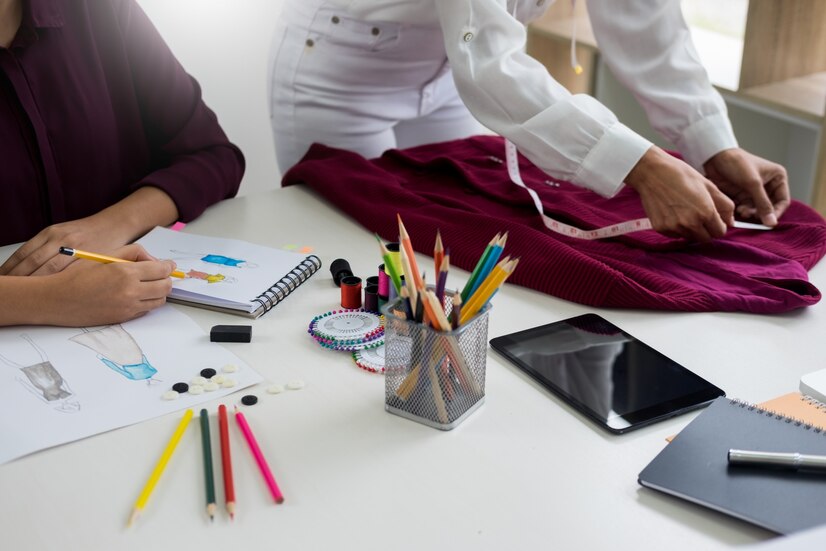Introduction
Fashion design is more than just sketching and sewing—it’s a dynamic journey of creativity, discipline, and discovery. A typical day in the life of a fashion design student is a blend of hands-on learning, artistic exploration, and academic rigor. Let’s step into their shoes and experience the excitement of designing the future of fashion.

Morning: Kickstarting the Day with Inspiration
The day begins early, often with a strong cup of coffee and a sketchbook in hand. Mornings are prime time for brainstorming new ideas, researching current trends, and revisiting mood boards created for ongoing projects. Many students spend this time browsing fashion magazines, online platforms like Pinterest, or analyzing the latest runway collections for inspiration.
Once energized and inspired, it’s time to head to the campus or studio. Students typically have a mix of practical and theoretical classes scheduled, ensuring a balanced approach to learning.
Mid-Morning: Practical Classes and Creative Exploration
The hands-on sessions are where the magic happens. These practical classes focus on fundamental skills such as:
- Pattern-Making: Students draft and cut patterns that form the basis of garment construction.
- Draping Techniques: Manipulating fabric on dress forms to create new silhouettes.
- Sewing and Embroidery: Practicing precise techniques to bring designs to life.
During these sessions, the atmosphere buzzes with creativity. Sewing machines hum, scissors snip through fabric, and instructors offer personalized guidance. Mistakes are part of the learning process, and every student’s workstation becomes a unique space of innovation.

Lunchtime: Refueling and Networking
Lunch breaks are more than just a time to eat; they’re a chance to connect with peers. Students often share ideas, seek feedback on their projects, and discuss upcoming assignments. Friendships formed during these breaks become invaluable, creating a sense of camaraderie in what can be an intense and competitive field.
Afternoon: Theory and Business of Fashion
Afternoon sessions often delve into the theoretical aspects of fashion. Courses may cover:
- Textile Science: Understanding different fabrics, their properties, and their applications.
- Fashion History: Learning about iconic designers and the evolution of styles over centuries.
- Branding and Marketing: Exploring how to position a fashion label in a competitive market.
These classes prepare students to not only design but also think strategically about how their creations can succeed in the real world. Discussions often revolve around sustainability, ethical fashion, and adapting to global trends.

Early Evening: Project Work and Deadlines
As classes wind down, students shift their focus to ongoing projects. This is when they apply the skills learned during the day to their designs. Projects may include:
- Creating a mini collection for a portfolio.
- Preparing for an upcoming fashion show.
- Experimenting with unconventional materials to push creative boundaries.
Meeting deadlines is a constant challenge. Balancing creativity with practicality teaches students the importance of time management and perseverance.
Evening: Reflection and Self-Development
Evenings are often spent refining designs or catching up on research. For many, this is a time of quiet reflection and self-development. Journaling ideas, sketching late into the night, or experimenting with new techniques are common practices. Some students also use this time to build their online portfolios or update their social media with glimpses of their work, gaining exposure and feedback.

The Thrill of Fashion Education
Being a fashion design student is demanding, but it’s equally rewarding. Each day is an opportunity to learn something new, push creative limits, and take a step closer to a dream career. It’s a lifestyle filled with passion, hard work, and the constant thrill of creating wearable art that can shape trends and influence the world.
Conclusion
If you’ve ever dreamed of joining this exciting journey, now is the time to step into the world of fashion design and let your creativity soar!

